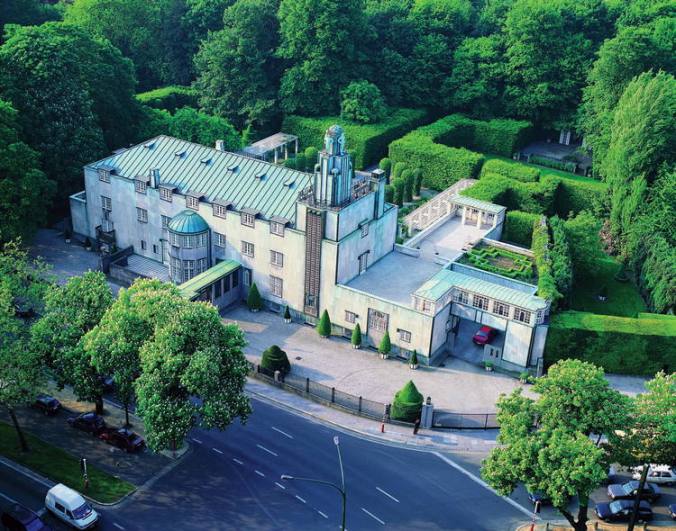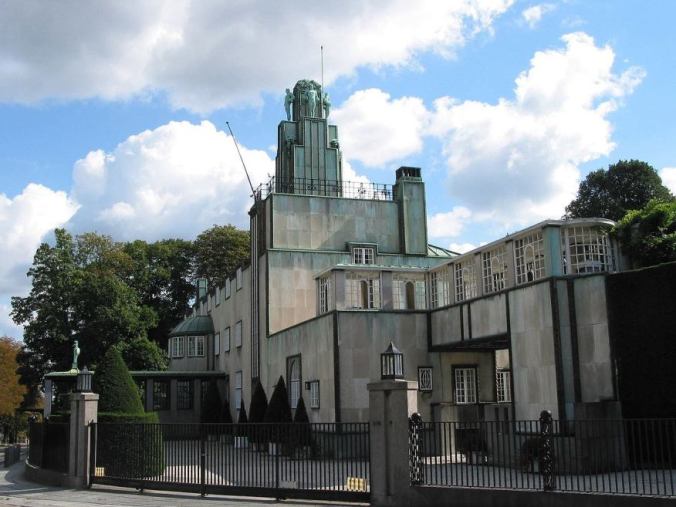
The Palais Stoclet is a large private mansion located in Brussels, Belgium, designed by architect and designer Josef Hoffmann, prominent member of the Vienna Secession and one of the founding members of the Wiener Werkstätte (“Viennese Workshops”). Under Hoffmann’s supervision along with an elite team of artists and craftsmen of the Wiener Werkstätte, the palace was completed after 6 years of construction as an ideal realization of the “total work of art,” or “Gesamtkunstwerk,” which meant to unify the applied and fine arts.
The lavish home was built for Adolphe Stoclet, a wealthy banker, engineer and art collector. Adolphe placed no financial or aesthetic restrictions or specifications on the project, only that he wanted “nothing left to chance.” This gave Hoffmann and his team of collaborating artists, who were also prominent members of the Vienna Secession and Wiener Werkstätte, creative and stylistic reign to artfully compose every element of experience within the home, including the building’s façade, walls, flooring, furniture, light fixtures, gardens, flower beds, linens, silverware, artwork, and even accessories for the toilet.
The structure designed by Hoffmann features a geometric façade of white Norwegian marble, and an extensive team of collaborating artists of the Wiener Werkstätte contributed to the interior ornamentation and design, including Gustav Klimt, Koloman Moser, Leopold Forstner, Carl Otto Czeschka, Franz Metzner, Richard Luksch, Michael Powolny, and George Minne. Klimt designed the large mosaic friezes surrounding the formal dining room table, with surrounding seats for 24 attendees. Every element within the interior has been meticulously crafted in a geometrically inspired pattern with the highest quality materials that money could buy, and in the case of Palais Stoclet, there was no limit to what they were willing to spend for a completely idealized living space.


Orthogonal features and controlled curves within the design structure epitomize the influence of the Vienna Secession and the break away from historical tradition in architecture. Palais Stoclet was an innovative architectural accomplishment in 1911, and was an inspiration to other designers and a precursor to Art Deco and Modernism in architecture.

Adolphe Stoclet and his wife passed away in 1949, leaving the home to their heirs by means of a shareholders association, which intended to keep everything intact and preserved. The palace remains private and blocked off from the public to-date, and has reportedly caused strife amongst the family members in recent years, who are struggling to hold on to the home as a private residence while maintaining the levels of conservation required to preserve this “Gesamtkunstwerk” masterpiece. Uninhabited since a family death in 2002, the house remains tucked away from the public eye, and even a lucky researcher that was granted access inside the home was not permitted to share the photographs with the public. Although elusive as it may seem, Palais Stoclet was recognized as a world heritage cite by UNESCO in 2009 for its high level of integrity in its authenticity, preservation, and the distinct new architectural style that embodies the totality of the Wiener Werkstätte. Since then, the Brussels regional government has drawn out a $1.7 million restoration plan to aid in conserving the site. Using such a large sum of taxpayer’s money to restore a private residence blocked off from the public has created reasonable controversy, although the future of the Palace remains uncertain. Eventually, the Stoclet family may open the doors as a museum, or if the home is defaulted to the government by some form of unforeseen circumstances, the palace will at least remain intact and preserved as if it were still 1911.

The Stoclet House remains as one of the most comprehensive and complete emblematic achievements of the Wiener Werkstätte.
Betsky, Aaron. “The Palais Stoclet Seduces.” Architect. The Journal of the American Institute of Architects, 04 Oct. 2013. Web. 28 Sept. 2016. <http://www.architectmagazine.com/design/the-palais-stoclet-seduces_o>.
“Josef Hoffmann.” Neue Galerie New York. Ronald S. Lauder Neue Galerie New York, n.d. Web. 28 Sept. 2016.
<http://www.neuegalerie.org/collection/artist-profiles/josef-hoffmann#77>.
“Stoclet House.” UNESCO, UNESCO World Heritage Centre, 27 June 2009, <http://whc.unesco.org/en/list/1298>.
Wise, Michael Z. “An Enchanted House Becomes a Family’s Curse.” Architecture. The Wall Street Journal, 12 Feb. 2012. Web. 28 Sept. 2016.<http://www.wsj.com/articles/SB10001424052970204616504577172941334034970>.